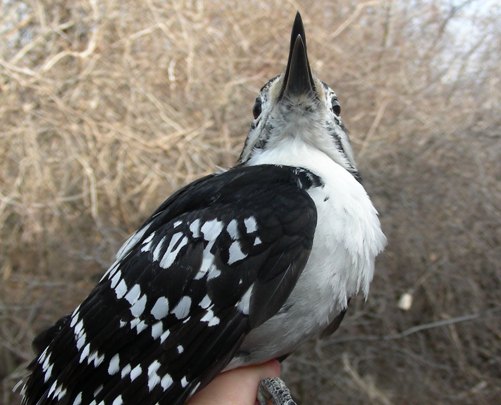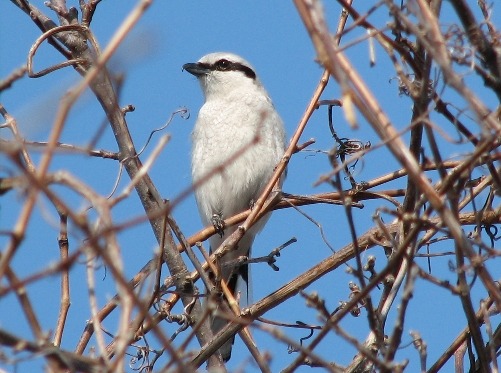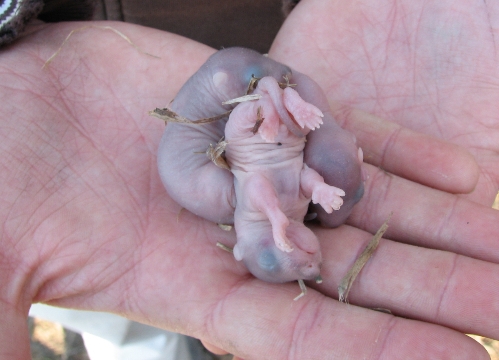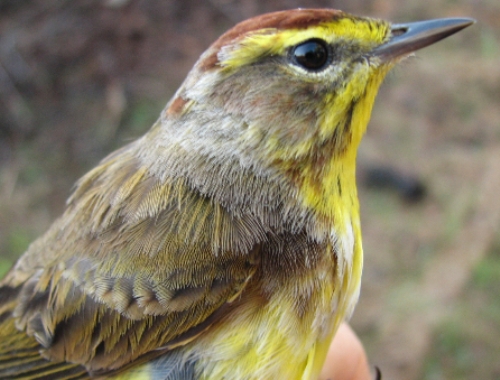|
McGILL BIRD OBSERVATORY |
||||||||||||||||||||||||||||||||||||||||||||||||||||||||||||||||||
Welcome
to the McGill Bird Observatory weekly report.
Click here for a complete listing of our archives.
Bander-in-charge: Marie-Anne Hudson, Barbara Frei Notes: Apparently Mother Nature decided that we’d had a hard enough winter this year, what with all the snow, and decided to cut us some slack, skipping spring and launching right into summer! The afternoon temperatures have hovered around 23 degrees throughout the week, making for some slightly sun-burnt but happy banders. We’ve managed to add 20 new species to the spring and 2008 lists, allowing us to close the gap a little between 2007 and 2008 in terms of species observed (71 vs 69). With all the good weather we’ve also managed to band almost three times as many birds as compared to last year’s first week of banding. As is the case in early spring we have more returns than repeats, signaling the return of our local breeders and perhaps also some birds showing migratory stop-over fidelity. This is a very interesting aspect of migration that we’re keeping our eye on after noticing that a few Song Sparrows were banded once last August in the first days of banding, reappearing only this week. One is a nice little return, two is interesting, but more than that makes you question where these birds spend their summers, if not at MBO. We’ve begun many little side projects this season, and this is sure to be one of them. We’ll be sure to keep you posted! In addition to the many highlights of the week that we’ll get into shortly, we’d like to take a minute to welcome our first intern, Simon Duval. Simon comes to us from Cégep de la Pocatière and will be spending the entire spring season with us. We welcome him and hope all our future interns will be as dedicated, quick to learn, eager and congenial as he is. Bienvenu Simon! In terms of highlights, our week began with the first day of banding for the season (Friday). And there’s no better way to begin the season than with a Northern Shrike! Add a litter of baby Red Squirrels (see below, in a nest box, not in the net) and you’ve got a busy day full of birds and babies, just how we like it. Saturday brought in a Savannah Sparrow and Sunday and Monday ushered in lots of new species as well. Tuesday was host to the beginning of a very noisy spring with Wood Frogs and Spring Peepers suddenly deciding to burst into “song”. How frogs can drown out birdsong we’ll never understand! Wednesday had us scanning the skies trying to add to our 10 Broad-winged Hawks and 3 Red-tailed Hawks that soared over us during our DETs, and Thursday rounded out a week of firsts with a Yellow Palm Warbler and a Yellow-shafted Flicker in the nets, and an Eastern Bluebird investigating a nest box. We’ve got our fingers and our toes crossed that it will decide to nest at MBO, which would be a first for us. Last year it was the Great Crested Flycatcher, this year it will hopefully be the bluebird, and next year… Purple Martins perhaps? This week’s top 10 banded species is no surprise with the wave of kinglets coming through at the moment - more in one week than we banded all of last spring! We’re sure there will be a major shift come next week’s top ten, as the Fox Sparrows are already coming down in number, the American Tree Sparrows are pretty much gone, and the warblers are coming! The number of Fox Sparrows this week was also remarkable, as we banded more in seven days than over the past three spring seasons combined. Otherwise this week’s list is similar to last year’s at this time, though much more sparrow-y. This week’s top 10 observed species is also similar to last year’s, and somewhat similar to last week’s with the top four spots remaining fairly consistent. The addition of high-flying Common Grackle flocks, tinkling Ruby-crowned Kinglets and mournfully singing Fox Sparrows have shaken the top 10 up a little, but the usual suspects remain on the list (Song Sparrow, American Crow, and American Robin). This week has been quite wonderful, so we very much look forward to what next week will bring!
|




